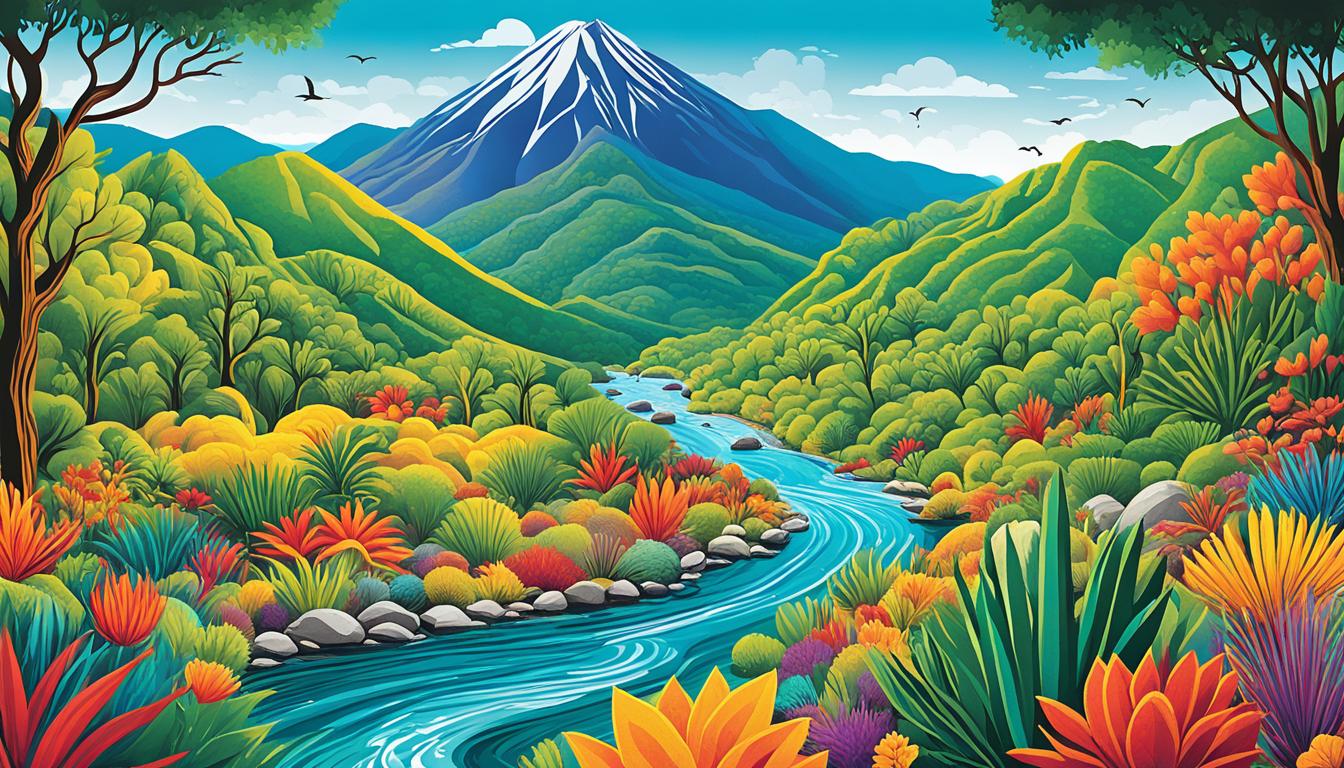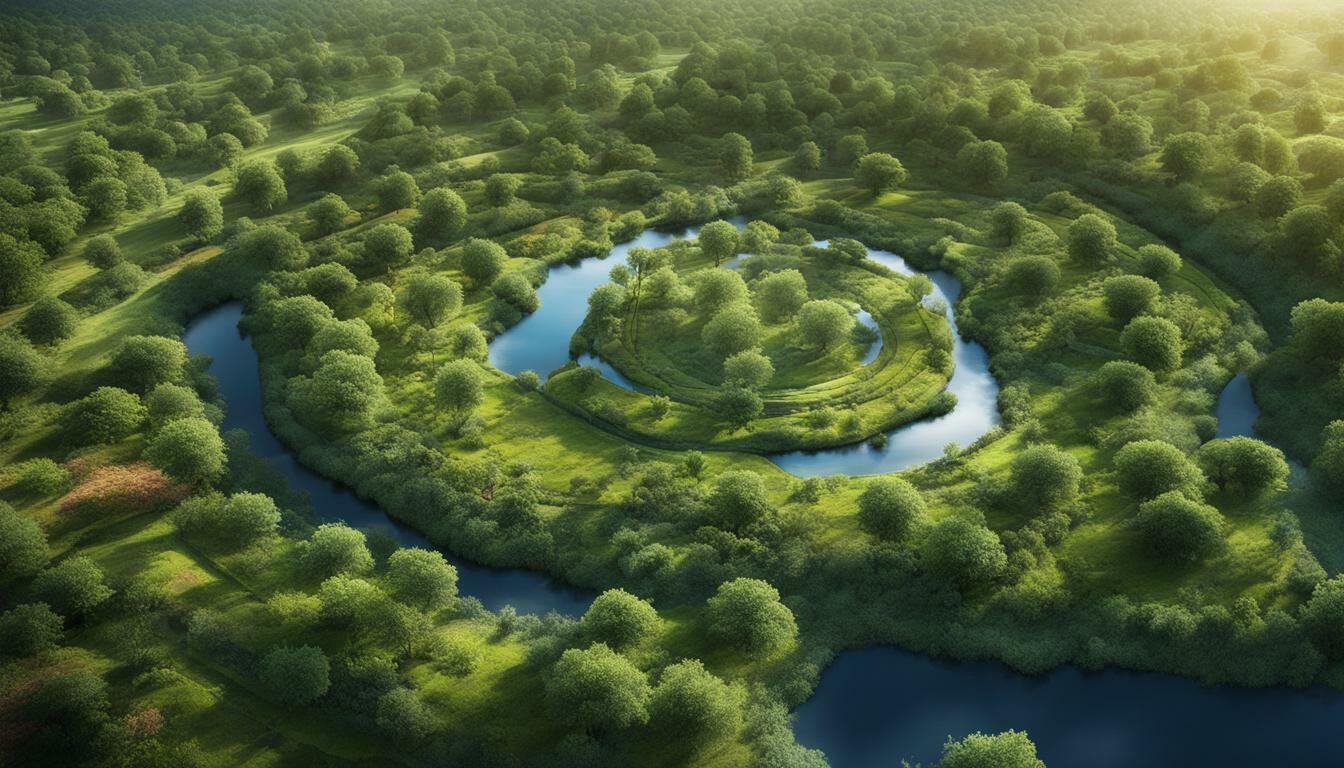Micronesia Sacred Natural Sites and Biodiversity
Did you know that Micronesia is home to some of the most biologically diverse coral reefs and forests on the planet? With nearly 1,000 species of fish, over 350 species of hard coral, and 1,200 species of mollusks, the reefs alone contribute to the rich biodiversity of this unique region. Add to that over 1,239 species of ferns and flowering plants, including many endemic species, and you have a true ecological wonderland. But this remarkable biodiversity is not without its challenges.
Key Takeaways:
- Micronesia is home to diverse coral reefs, forests, and endemic species.
- The region’s biodiversity is threatened by various factors, including habitat loss and climate change.
- Sacred natural sites play a crucial role in the conservation of Micronesia’s biodiversity.
- Micronesia has implemented conservation measures and established protected areas to safeguard its unique ecosystems.
- Efforts are needed to secure funding, strengthen capacity-building, and integrate biodiversity considerations across sectors to ensure long-term conservation success.
The Importance of Sacred Natural Sites
Sacred natural sites hold immense significance in the biodiversity conservation efforts of Micronesia. These sites not only hold ecological value but also embody cultural heritage. They are integral components of the indigenous communities’ traditional knowledge and practices, serving as sacred spaces for rituals, ceremonies, and spiritual connection to the land. Maintained and managed by local communities, these sites ensure the safeguarding of unique ecosystems and the preservation of cultural heritage.
The preservation of Micronesia’s sacred natural sites contributes to the harmonious coexistence of humans and nature, fostering a deep sense of respect and reverence for the environment. These sites serve as natural sanctuaries for endangered species and provide essential habitats for a diverse range of plants and animals, promoting biodiversity conservation. By protecting these sacred sites, Micronesia can not only conserve its rich cultural heritage but also strengthen its efforts towards sustainable development and ecotourism.
Biodiversity Conservation Efforts in Micronesia
Micronesia is committed to the conservation and protection of its unique biodiversity through various initiatives and strategies. The implementation of the Convention on Biological Diversity is a priority, and Micronesia has taken significant steps to enhance its efforts in this regard.
The cornerstone of Micronesia’s conservation approach is the National Biodiversity Strategy and Action Plan (NBSAP). This comprehensive plan guides the sustainable development of the country across social, economic, and environmental pillars. It encompasses specific objectives and targets for species management, sustainable use of genetic resources, agro-biodiversity, and the promotion of ecological sustainable industry.
To safeguard and preserve biodiversity, Micronesia has established a network of protected areas, locally managed marine areas, and biosphere reserves. These areas serve as vital habitats for various species and contribute to the overall health and resilience of ecosystems. By designating these protected areas, Micronesia is actively working towards the conservation and restoration of its natural heritage.
In addition to protected areas, Micronesia is making a conscious effort to incorporate biodiversity considerations into national policies, programs, and public funds. This integration ensures that biodiversity conservation is woven into the fabric of decision-making processes at every level, promoting sustainable practices and development.
Conservation Initiatives
Micronesia’s conservation efforts are not limited to legal and policy frameworks. The government recognizes the vital role of indigenous communities in biodiversity conservation. They have been actively engaged in the development and implementation of conservation initiatives, drawing upon their traditional knowledge and practices. By empowering indigenous communities, Micronesia is fostering a sense of ownership and responsibility towards their natural surroundings, leading to more effective conservation outcomes.
The government is also forging partnerships with international organizations, NGOs, and research institutions to further enhance its conservation efforts. Collaborative projects are underway to tackle specific challenges such as habitat restoration, invasive species management, and biodiversity research. These partnerships ensure that Micronesia benefits from global expertise and resources while contributing to the broader conservation efforts worldwide.
Through its comprehensive conservation approach, Micronesia is actively working towards the preservation of its unique environmental heritage. By integrating biodiversity considerations into national strategies, engaging indigenous communities, and fostering international partnerships, Micronesia is taking substantial steps towards a sustainable and biodiverse future.

Threats to Biodiversity in Micronesia
Micronesia’s rich biodiversity is under threat from a variety of factors, both natural and human-induced. These threats, which include land degradation, climate change, alien invasive species, and habitat loss, pose significant challenges to the region’s unique ecosystems.
The process of land degradation, caused by deforestation and unsustainable land use practices, results in a loss of biodiversity. Micronesia’s forests have been particularly affected, with large areas being cleared for agriculture, urbanization, and infrastructure development.
Climate change poses a significant and ongoing threat to Micronesia’s biodiversity. Rising sea levels, increased temperature, and extreme weather events, such as tropical storms, can cause habitat destruction and disrupt critical ecological processes.
A further danger to Micronesia’s biodiversity comes from alien invasive species, which are non-native organisms that, when introduced to a new environment, can outcompete native species and disrupt ecosystem balance. These invasions can lead to a loss of biodiversity and negatively impact local communities who rely on the natural resources.
| Threats to Biodiversity in Micronesia | Description |
|---|---|
| Land Degradation | Deforestation and unsustainable land use practices result in a loss of biodiversity. |
| Climate Change | Rising sea levels, increased temperature, and extreme weather events disrupt critical ecological processes. |
| Alien Invasive Species | Non-native organisms outcompete native species, leading to a loss of biodiversity. |
It is crucial to address these threats to protect Micronesia’s unique ecosystems and the biodiversity they support. Efforts must be made to promote sustainable land use practices, combat climate change through mitigation and adaptation strategies, and control and prevent the spread of invasive species.
By raising awareness and implementing effective conservation measures, Micronesia can safeguard its diverse flora and fauna for future generations to enjoy and benefit from.
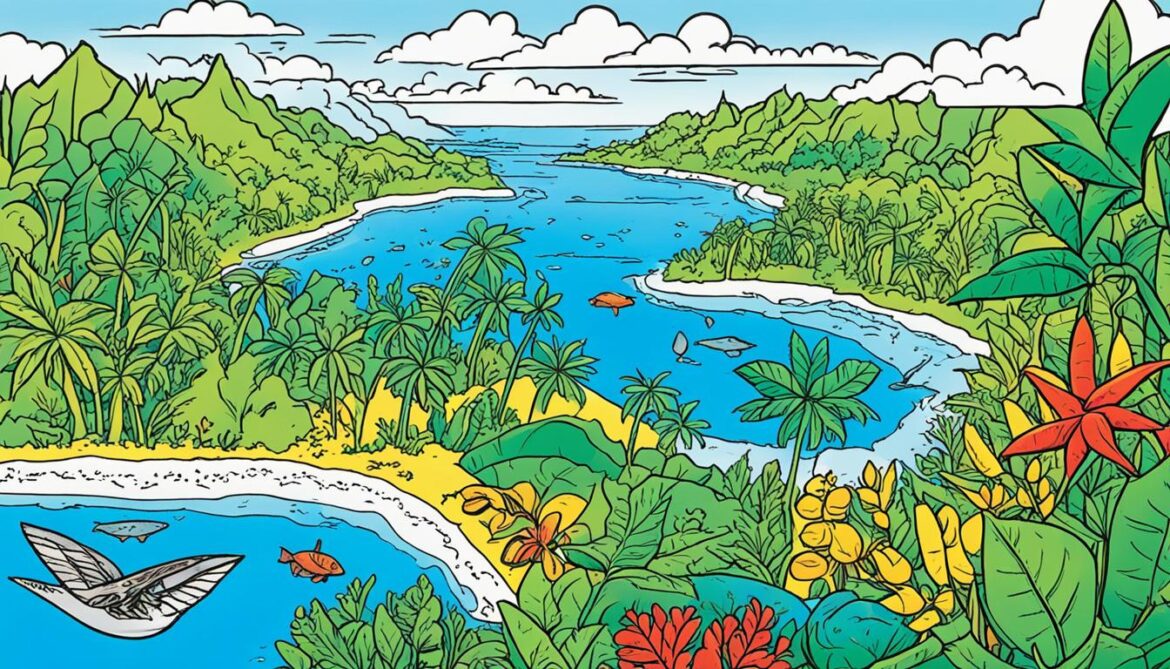
Actions Taken for Biodiversity Conservation
Micronesia has implemented various actions and initiatives to achieve the 2020 Aichi Biodiversity Targets and protect its unique biodiversity. These conservation actions encompass the establishment of terrestrial protected areas, locally managed marine areas, and biosphere reserves throughout the islands.
One of the key focuses of Micronesia’s conservation efforts is the restoration and protection of key species such as giant clams, sponges, and corals. Restoration programs have been implemented to ensure the survival and thriving populations of these vital marine organisms.
Ongoing rapid ecological assessments for corals and fish are conducted to monitor their health and the overall state of the marine ecosystems. This information is vital for effective conservation planning and decision-making.
Additionally, workshops and programs are held to address the control and management of invasive species, which pose a significant threat to Micronesia’s native flora and fauna.
Micronesia also recognizes the importance of research, monitoring, and information-sharing in biodiversity conservation. Efforts are being made to increase biodiversity research activities and establish robust monitoring systems to track the progress and effectiveness of conservation actions.
“Conservation actions include the establishment of protected areas, restoration programs for key species, rapid ecological assessments, invasive species control, and biodiversity research and monitoring.”
The table below highlights the various conservation actions taken in Micronesia:
| Conservation Actions | Objectives |
|---|---|
| Establishment of terrestrial protected areas, locally managed marine areas, and biosphere reserves | To safeguard critical habitats and ecosystems |
| Restoration programs for giant clams, sponges, and corals | To ensure the survival and thriving populations of key species |
| Rapid ecological assessments for corals and fish | To monitor the health of marine ecosystems and inform conservation planning |
| Invasive species control workshops and programs | To manage and mitigate the impact of invasive species on native biodiversity |
| Biodiversity research, monitoring, and information-sharing | To enhance understanding, track progress, and support conservation efforts |
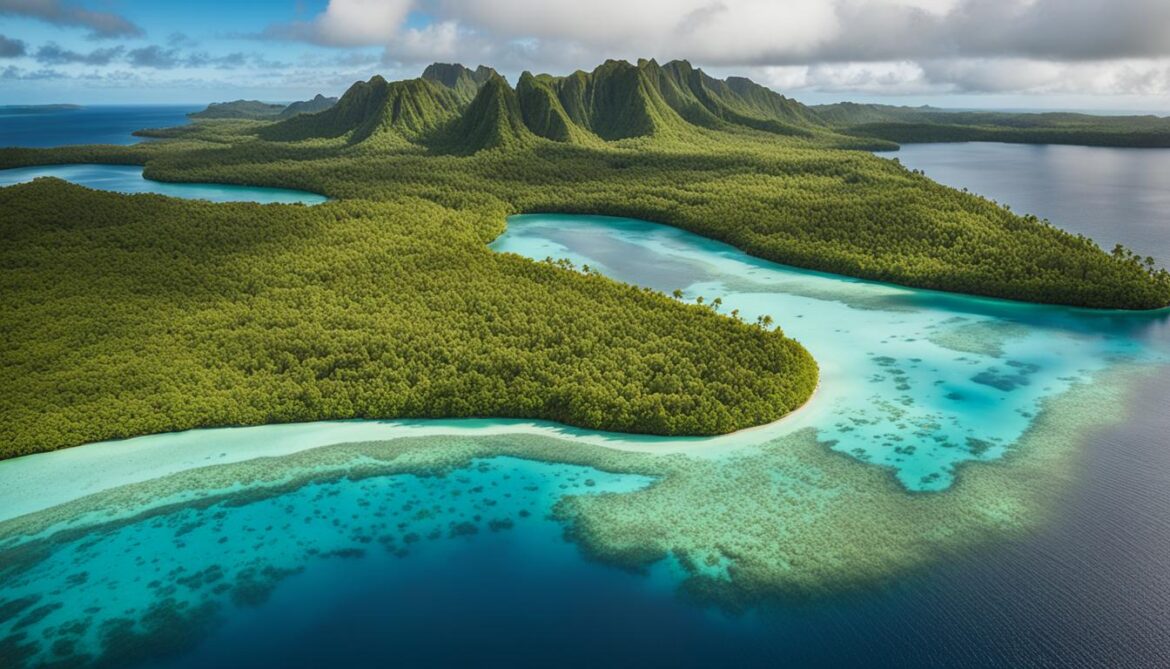
The conservation actions in Micronesia aim to ensure the long-term survival of the region’s unique biodiversity and contribute to global efforts in protecting our planet’s natural heritage.
Support Mechanisms for Biodiversity Conservation
Efforts to conserve biodiversity in Micronesia are supported by various mechanisms, including funding, capacity-building initiatives, and the mainstreaming of biodiversity considerations into policies and programs.
One important source of resource availability for biodiversity conservation is domestic funding obtained through annual US Compact funds. In the Environment sector alone, an estimated $2 million is allocated each year. This funding enables the implementation of conservation projects and initiatives across the islands of Micronesia.
Mainstreaming biodiversity considerations into national policies and programs has been a significant milestone in conservation efforts. This has been achieved through the incorporation of National Biodiversity Strategy and Action Plan (NBSAP) themes and actions into the National Strategic Development Plan and other relevant frameworks.
However, despite these achievements, challenges persist in enforcing ecosystem management plans and various laws and regulations. Additional efforts are required to secure more funding, strengthen capacity-building initiatives, enhance coordination amongst stakeholders, and further integrate biodiversity considerations across sectors.
Capacity-building Initiatives
- Training programs to enhance the capacities of local communities, conservation organizations, and government agencies in biodiversity conservation
- Workshops and knowledge-sharing sessions on sustainable resource management and conservation practices
- Technical assistance to support the development and implementation of biodiversity conservation projects
- Support for research and monitoring activities to improve understanding of ecosystems and species
Mainstreaming Biodiversity
“Mainstreaming biodiversity considerations into national policies and programs is vital for ensuring long-term sustainability and conservation of Micronesia’s unique ecosystems and species.” – Micronesia Environmental Agency
Integrating biodiversity into mainstream policies and programs is key to embedding conservation principles at all levels of decision-making. By considering the impacts on biodiversity and incorporating conservation strategies into various sectors such as agriculture, tourism, and infrastructure development, Micronesia can effectively promote sustainable practices.
Furthermore, partnering with indigenous communities, non-governmental organizations, and stakeholders from diverse sectors can facilitate the exchange of knowledge and expertise, fostering collaboration towards shared conservation goals.
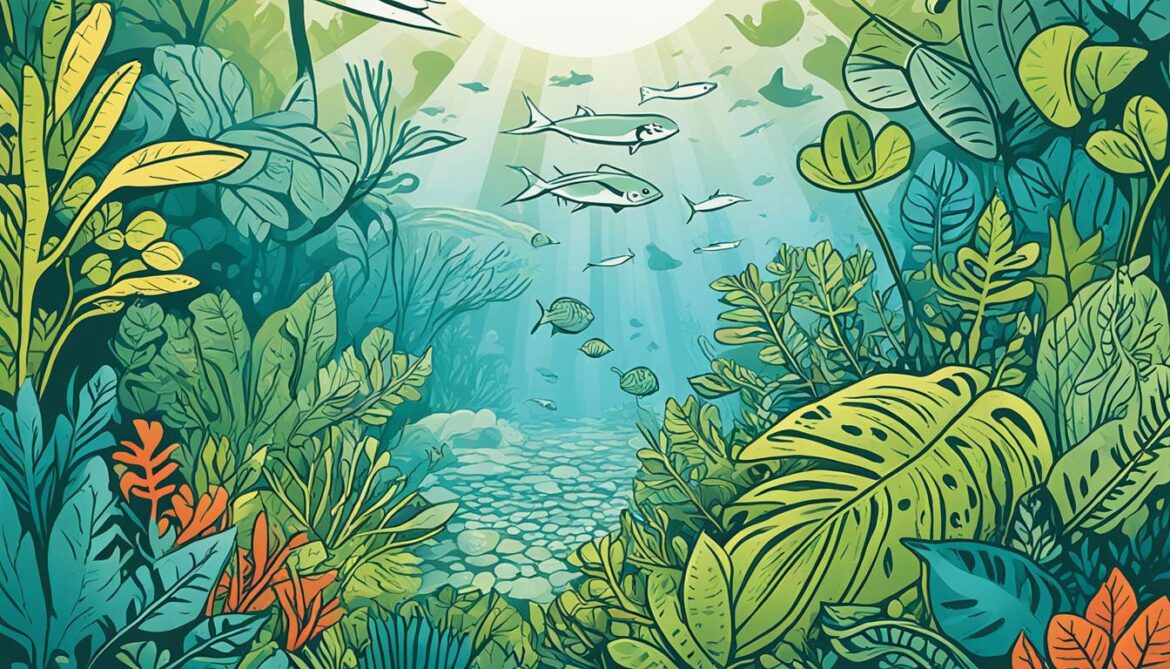
| Support Mechanisms | Key Focus Areas |
|---|---|
| Conservation Funding |
|
| Capacity-building |
|
| Mainstreaming Biodiversity |
|
By leveraging these support mechanisms, Micronesia can enhance its biodiversity conservation efforts, protect its unique ecosystems, and promote sustainable development for future generations.
Monitoring and Reviewing Implementation
Monitoring and reviewing the implementation of biodiversity conservation measures in Micronesia is crucial to ensure the effectiveness of conservation efforts. By regularly assessing progress and reviewing the status of priority species, taxonomic groups, and ecological sites, conservation strategies can be adjusted and improved over time.
Evaluating Progress with National Reports
One important step in monitoring implementation is the preparation of national reports that provide comprehensive information on the state of biodiversity in Micronesia. These reports outline the progress made in achieving conservation targets and highlight areas that require further attention. By analyzing the data and findings presented in these reports, policymakers and conservation practitioners can identify gaps and develop strategies to address them.
Establishing Monitoring Plans
In addition to national reports, the establishment of monitoring plans is essential for effective implementation review. These plans set out clear objectives, well-thought-out targets, and reliable indicators that enable the measurement and evaluation of conservation efforts. By collecting relevant data and monitoring key parameters, such as species populations, habitat quality, and ecosystem resilience, conservation practitioners can track progress and make informed decisions.
Generating Relevant Information
Various studies and programs are generating relevant information to support the monitoring and review process. These initiatives focus on collecting data on priority species, monitoring ecological sites, and conducting research on specific taxonomic groups. By gathering this information, conservation practitioners gain valuable insights into the state of biodiversity in Micronesia, allowing for evidence-based decision-making.
“Regular evaluations and reporting facilitate adaptive management and inform future conservation actions.”
– Micronesia Conservation Review Board
Adaptive Management and Future Conservation Actions
Regular evaluations and reporting are fundamental to adaptive management and future conservation actions. By analyzing the data and information collected through monitoring and review processes, conservation practitioners can identify gaps, successes, and emerging threats, enabling them to adapt their strategies accordingly. This iterative approach helps ensure that conservation actions remain responsive to changing circumstances and effective in achieving their goals.
Monitoring and Reviewing Implementation Table
| Key Aspect | Monitoring Activity | Objective |
|---|---|---|
| Priority Species | Regular population surveys | To track population trends and identify conservation needs |
| Ecological Sites | Monitoring program | To assess the health and resilience of key ecological sites |
| Species Diversity | Biodiversity assessments | To determine species richness and identify areas of high conservation value |
| Habitat Quality | Habitat monitoring | To evaluate and improve the condition of critical habitats |
Regular monitoring and review of implementation provide valuable insights into the effectiveness of conservation efforts in Micronesia. These processes enable adaptive management, inform future actions, and contribute to the long-term preservation of the region’s unique biodiversity.
Nan Madol: Ceremonial Centre of Eastern Micronesia
Nan Madol is a UNESCO World Heritage site located off the coast of Pohnpei Island. This ceremonial centre consists of more than 100 islets built with walls of basalt and coral boulders. The ruins represent the grandeur and complexity of the Saudeleur dynasty, a vibrant period of Pacific Island culture. Nan Madol showcases the development of chiefly societies, their social and religious practices, and the monumental architecture of the time. However, the site is facing threats such as siltation of waterways and vegetation overgrowth, which requires conservation efforts to preserve its outstanding universal value.
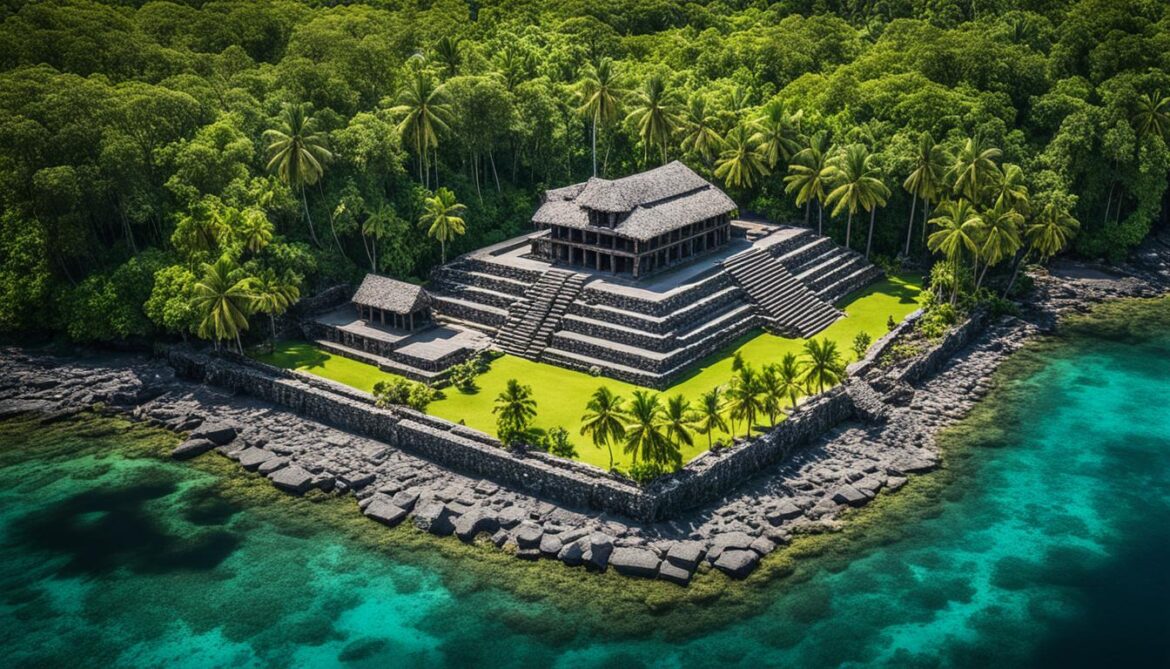
Importance of Micronesia’s Sacred Natural Sites for Biodiversity Conservation
Micronesia’s sacred natural sites play a crucial role in biodiversity conservation efforts. These sites often serve as sanctuaries for endangered species and provide important habitats for plants and animals. They also contribute to the preservation of traditional knowledge and cultural heritage. By leveraging the ecological and cultural value of these sites, Micronesia can promote sustainable ecotourism and engage local indigenous communities in conservation strategies.
The sacred natural sites of Micronesia are more than just areas of ecological significance; they hold deep cultural and spiritual value to the indigenous communities. These sites have been designated as sacred due to their association with ancient traditions and rituals practiced by the local people for generations.
One example of such a sacred site is the Nan Madol, a UNESCO World Heritage site located off the coast of Pohnpei Island. Nan Madol is a remarkable ceremonial center consisting of more than 100 islets built with walls of basalt and coral boulders. It represents the grandeur and complexity of the Saudeleur dynasty and showcases the development of Pacific Island culture during that time.
“The sacred natural sites provide a unique opportunity to conserve both biodiversity and cultural heritage. They are places of immense spiritual and cultural importance to the local communities, and their protection is crucial for the sustainable future of Micronesia,” says Dr. Leilani Takano, a conservation expert in Micronesia.
These sacred sites, with their pristine ecosystems and rich cultural history, hold immense potential for sustainable ecotourism. Responsible tourism can enhance the economic value of these areas while creating incentives for their preservation. Visitors can appreciate the natural beauty and cultural heritage of Micronesia, generating revenue that can be reinvested in conservation efforts.
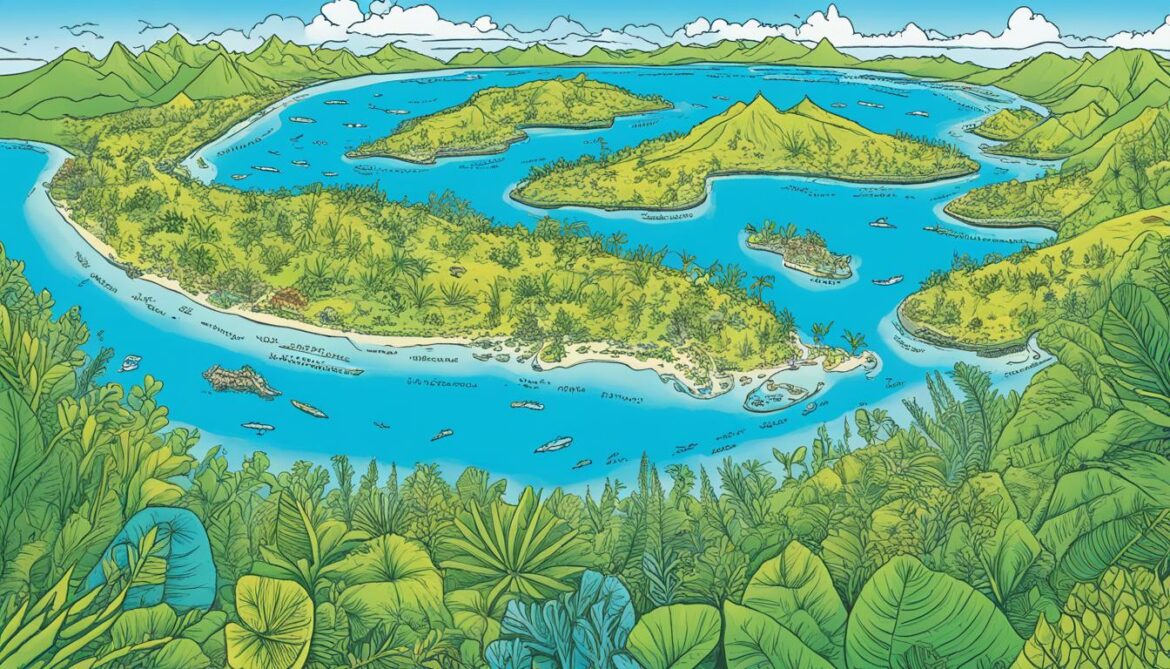
By highlighting the significance of these sacred sites, Micronesia can raise awareness and support for biodiversity conservation. Engaging local indigenous communities in the management and monitoring of these sites ensures that conservation efforts are aligned with cultural practices and traditions. It also empowers communities to take an active role in protecting and preserving their natural and cultural heritage.
Conservation Strategies for Micronesia’s Sacred Natural Sites
There are several key strategies that can be employed to protect and conserve Micronesia’s sacred natural sites:
- Developing sustainable ecotourism practices that benefit local communities and ensure the protection of biodiversity.
- Implementing effective land and marine management plans that consider the ecological and cultural significance of these sites.
- Establishing partnerships between government agencies, local communities, and international organizations to support conservation efforts.
- Promoting education and awareness programs to enhance understanding and appreciation of the value of these sites.
- Integrating traditional knowledge and practices into conservation strategies to ensure the preservation of cultural heritage.
By implementing these strategies, Micronesia can secure a sustainable future for its sacred natural sites, preserving both its biodiversity and cultural heritage for generations to come.
| Benefits of Protecting Micronesia’s Sacred Natural Sites | Conservation Strategies for Sacred Natural Sites |
|---|---|
| Preservation of endangered species and important habitats | Developing sustainable ecotourism practices |
| Protection of traditional knowledge and cultural heritage | Implementing effective land and marine management plans |
| Enhanced economic value through responsible tourism | Establishing partnerships between stakeholders |
| Raising awareness and support for biodiversity conservation | Promoting education and awareness programs |
| Engagement and empowerment of local indigenous communities | Integration of traditional knowledge into conservation strategies |
Through the preservation of Micronesia’s sacred natural sites, the islands can continue to be a haven for biodiversity and a testament to the rich cultural heritage of the region.
Ecotourism and Sustainable Development in Micronesia
Micronesia, with its breathtaking natural and cultural heritage, has the potential to become a hub for sustainable ecotourism. The pristine sacred natural sites, vibrant coral reefs, and rich traditional knowledge of the islands offer unique experiences for eco-conscious travelers seeking authentic encounters with nature.
To ensure the long-term success of ecotourism in Micronesia, it is crucial to implement responsible tourism practices. This includes minimizing the ecological footprint of visitors and supporting local communities in their efforts to preserve and share their cultural heritage.
By providing adequate infrastructure and services that align with sustainable practices, Micronesia can create a welcoming environment for eco-travelers. This includes promoting eco-friendly accommodation options, organic and locally sourced food, and transportation alternatives that minimize carbon emissions.
Promoting Community Engagement and Benefits
To maximize the benefits of tourism for local communities, it is important to engage them in the decision-making process and ensure they receive a fair share of the economic benefits. This can be achieved through initiatives such as community-based tourism projects, where local communities actively participate in tourism activities and receive direct economic benefits.
“Sustainable tourism can empower local communities, preserving their unique heritage while creating economic opportunities.” – Micronesia Tourism Board
Empowering local communities through sustainable tourism not only enhances their livelihoods but also fosters a sense of pride and ownership in the protection of their natural and cultural assets.
Protecting Marine Areas and Promoting Sustainable Fishing Practices
Given Micronesia’s extensive marine biodiversity, protecting its marine areas and promoting sustainable fishing practices are essential for the long-term preservation of its marine ecosystems.
To achieve this, the government of Micronesia, in collaboration with local communities and international organizations, can establish marine protected areas (MPAs) and implement effective management plans. These MPAs would serve as sanctuaries for marine life, safeguarding critical habitats and allowing ecosystems to thrive.
Promoting sustainable fishing practices, such as the use of selective fishing methods and implementing catch limits, is also crucial for maintaining fish populations and preserving the delicate balance of marine ecosystems.
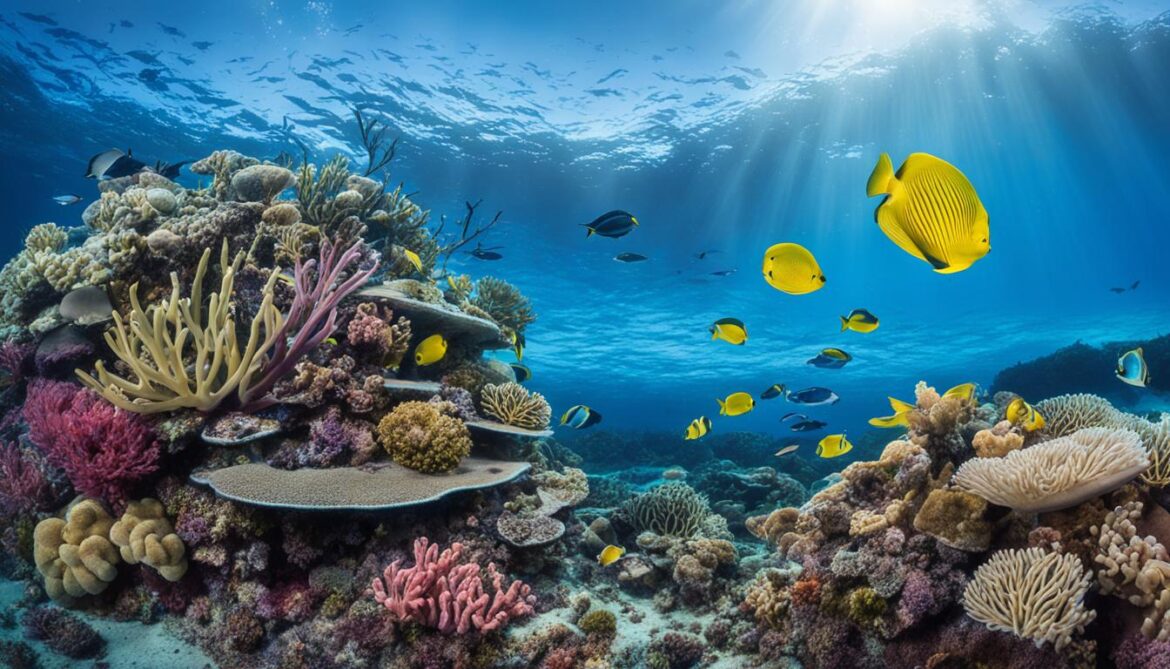
Driving Sustainable Development through Ecotourism
The development of sustainable ecotourism in Micronesia not only contributes to the conservation of biodiversity but also drives sustainable development on the islands. By providing economic opportunities, ecotourism can support local livelihoods, enhance infrastructure development, and improve access to essential services.
Furthermore, the revenue generated from ecotourism can be reinvested in conservation efforts, ensuring the long-term preservation of Micronesia’s unique natural and cultural heritage.
As Micronesia embraces ecotourism as a tool for sustainable development, it must balance economic growth with environmental protection and cultural preservation. It is essential to continue collaborating with local communities, government agencies, and international stakeholders to ensure that ecotourism in Micronesia remains sustainable, responsible, and beneficial for all.
Conclusion
Micronesia’s sacred natural sites and biodiversity are vital for the protection of both the environment and cultural heritage. The diverse ecosystems, including stunning coral reefs, lush forests, and sacred sites, contribute immensely to the overall well-being of the islands. However, Micronesia’s unique biodiversity is under threat from various factors, such as habitat loss, overexploitation, and climate change.
Preserving Micronesia’s precious natural and cultural heritage requires dedicated conservation efforts. The establishment of protected areas and the incorporation of biodiversity considerations into national policies are crucial steps in safeguarding Micronesia’s exceptional ecosystems. Additionally, collaboration among government agencies, local communities, and international stakeholders plays a pivotal role in ensuring the long-term viability of Micronesia’s biodiversity and sustainable development.
Through continued commitment and united action, Micronesia can protect its diverse wildlife, magnificent landscapes, and sacred natural sites. Conservation efforts must persist to overcome the challenges posed by habitat destruction and climate change. By working together, we can preserve and celebrate the remarkable biodiversity that defines Micronesia’s identity.




